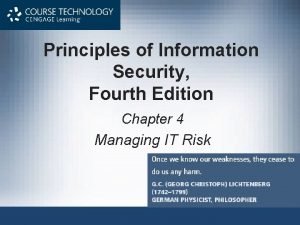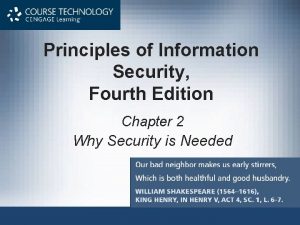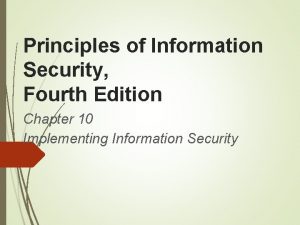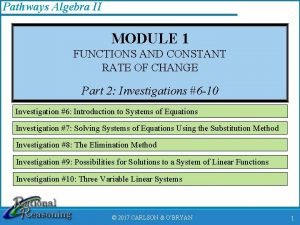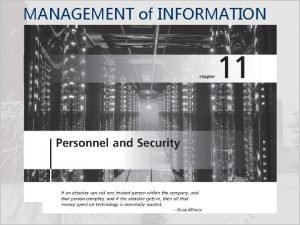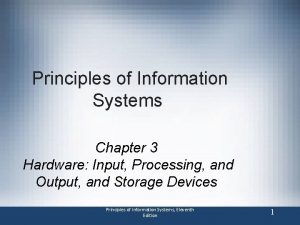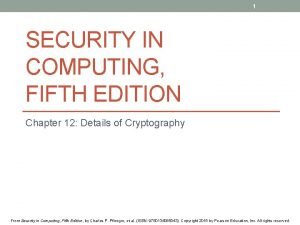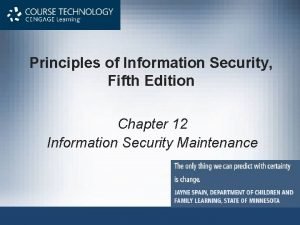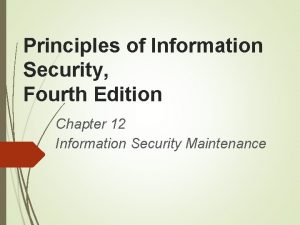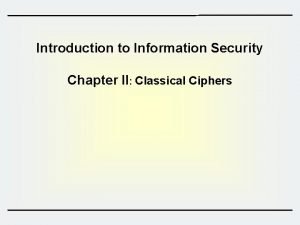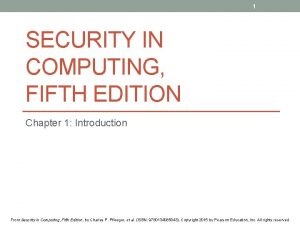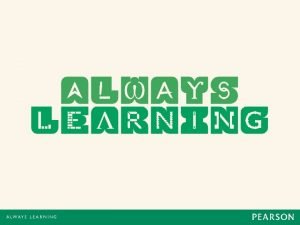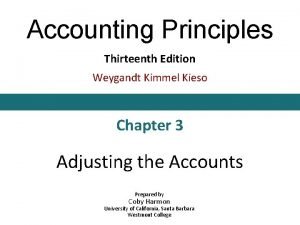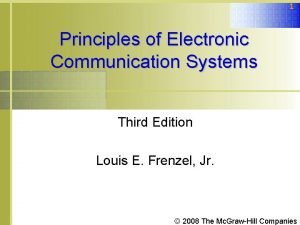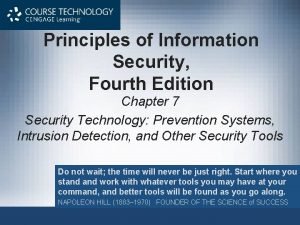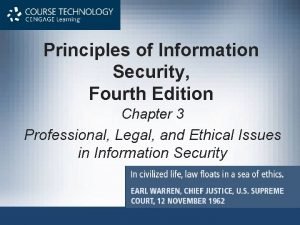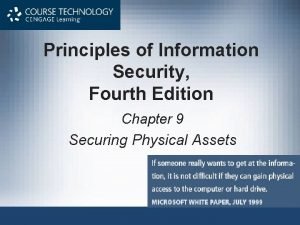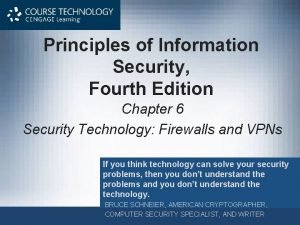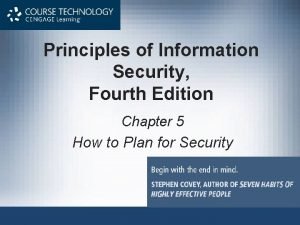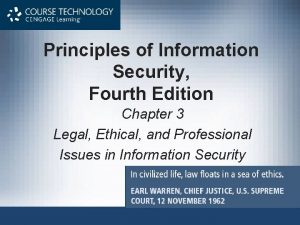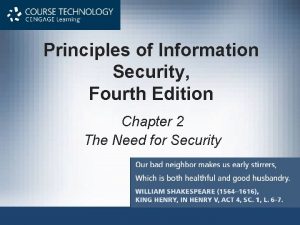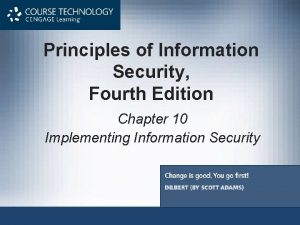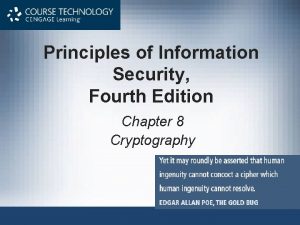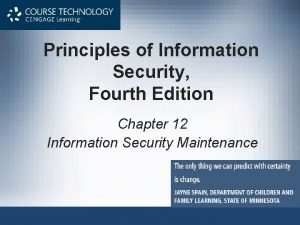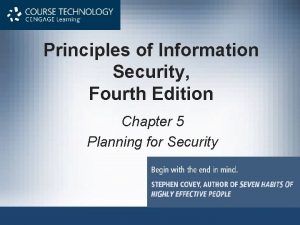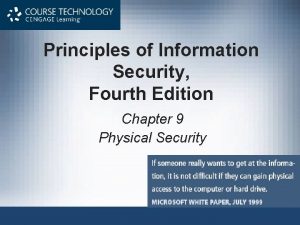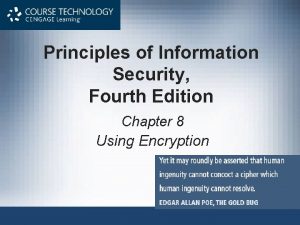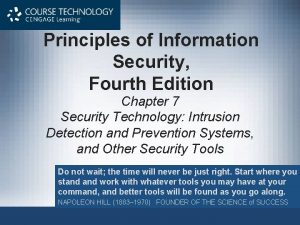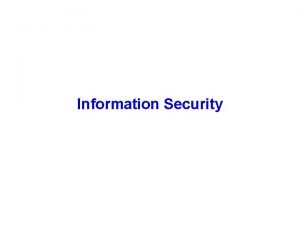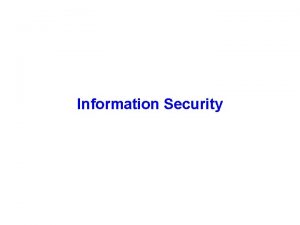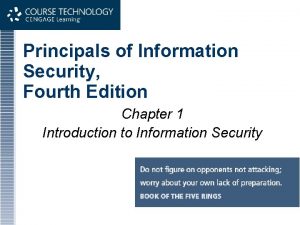Principles of Information Security Fourth Edition Chapter 1
















































- Slides: 48

Principles of Information Security, Fourth Edition Chapter 1 Introduction to Information Security

• Information security: a “well-informed sense of assurance that the information risks and controls are in balance. ” — Jim Anderson, Inovant (2002) • Security professionals must review the origins of this field to understand its impact on our understanding of information security today Principles of Information Security, Fourth Edition Introduction 2

• Began immediately following development first mainframes • Developed for code-breaking computations • During World War II • Multiple levels of security were implemented • Physical controls • Rudimentary • Defending against physical theft, espionage, and sabotage Principles of Information Security, Fourth Edition The History of Information Security 3

• Original communication by mailing tapes • Advanced Research Project Agency (ARPA) • Examined feasibility of redundant networked communications • Larry Roberts developed ARPANET from its inception • Plan • • Link computers Resource sharing Link 17 Computer Research Centers Cost 3. 4 M • ARPANET is predecessor to the Internet Principles of Information Security, Fourth Edition The 1960 s 4

The 1970 s and 80 s • • Individual remote sites were not secure from unauthorized users Vulnerability of password structure and formats No safety procedures for dial-up connections to ARPANET Non-existent user identification and authorization to system Principles of Information Security, Fourth Edition • ARPANET grew in popularity • Potential for misuse grew • Fundamental problems with ARPANET security 5

The 1970 s and 80 s (cont’d. ) • Rand Report R-609 • Scope of computer security grew from physical security to include: • Safety of data • Limiting unauthorized access to data • Involvement of personnel from multiple levels of an organization Principles of Information Security, Fourth Edition • Paper that started the study of computer security • Information Security as we know it began 6

MULTICS • Early focus of computer security research • First operating system created with security as its primary goal • Mainframe, time-sharing OS developed in mid-1960 s • GE, Bell Labs, and MIX • Several MULTICS key players created UNIX • Late 1970 s • Microprocessor expanded computing capabilities • Mainframe presence reduced • Expanded security threats Principles of Information Security, Fourth Edition • System called Multiplexed Information and Computing Service (MULTICS) 7

• Networks of computers became more common • Need to interconnect networks grew • Internet became first manifestation of a global network of networks • Initially based on de facto standards • In early Internet deployments, security was treated as a low priority Principles of Information Security, Fourth Edition The 1990 s 8

• Millions of computer networks communicate • Many of the communication unsecured • Ability to secure a computer’s data influenced by the security of every computer to which it is connected • Growing threat of cyber attacks has increased the need for improved security Principles of Information Security, Fourth Edition 2000 to Present 9

Principles of Information Security, Fourth Edition Vulnerabilities 10

What is Security? • • • Physical security Personal security Operations security Communications security Network security Information security Principles of Information Security, Fourth Edition • “The quality or state of being secure—to be free from danger” • A successful organization should have multiple layers of security in place: 11

• The protection of information and its critical elements, including systems and hardware that use, store, and transmit that information • Necessary tools: policy, awareness, training, education, technology • C. I. A. triangle • Was standard based on confidentiality, integrity, and availability • Now expanded into list of critical characteristics of information Principles of Information Security, Fourth Edition What is Security? (cont’d. ) 12

Figure 1 -3 Components of Information Security Principles of Information Security, Fourth Edition 13

Access Asset Attack Control, Safeguard, or Countermeasure • Exploit • Exposure • Loss • • • Protection Profile or Security Posture • Risk • Subjects and Objects • Threat Agent • Vulnerability Principles of Information Security, Fourth Edition Key Information Security Concepts 14

Key Information Security Concepts (cont’d. ) • Computer is used as an active tool to conduct attack • When the object of an attack • Computer is the entity being attacked Principles of Information Security, Fourth Edition • Computer can be subject of an attack • Computer can be the object of an attack • When the subject of an attack 15

Figure 1 -5 – Subject and Object of Attack Figure 1 -5 Computer as the Subject and Object of an Attack 16 Principles of Information Security, Fourth Edition

Critical Characteristics of Information • • Availability Accuracy Authenticity Confidentiality Integrity Utility Possession Principles of Information Security, Fourth Edition • The value of information comes from the characteristics it possesses: 17

Principles of Information Security, Fourth Edition CNSS Security Model Figure 1 -6 The Mc. Cumber Cube 18

• Information system (IS) is entire set of components necessary to use information as a resource in the organization • Software • Hardware • Data • People • Procedures • Networks Principles of Information Security, Fourth Edition Components of an Information System 19

• Impossible to obtain perfect security • Process, not an absolute • Security should be considered balance between protection and availability • Must allow reasonable access, yet protect against threats Principles of Information Security, Fourth Edition Balancing Information Security and Access 20

Figure 1 -6 – Balancing Security and Access Figure 1 -8 Balancing Information Security and Access Principles of Information Security, Fourth Edition 21

• Grassroots effort -systems administrators drive • Key advantage: technical expertise of individual administrators • Seldom works • Lacks number of critical features: • Participant support • Organizational staying power Principles of Information Security, Fourth Edition Approaches to Information Security Implementation: Bottom-Up Approach 22

• Initiated by upper management • Issue policy, procedures, and processes • Dictate goals and expected outcomes of project • Determine accountability for each required action • Most successful • Involves formal development strategy • Systems development life cycle Principles of Information Security, Fourth Edition Approaches to Information Security Implementation: Top. Down Approach 23

Figure 1 -9 Approaches to Information Security Implementation Principles of Information Security, Fourth Edition 24

• Systems Development Life Cycle (SDLC): • Methodology for design and implementation of information system • Methodology: • Formal approach to problem solving • Based on structured sequence of procedures • Using a methodology: • Ensures a rigorous process • Increases probability of success • Traditional SDLC consists of six general phases Principles of Information Security, Fourth Edition The Systems Development Life Cycle 25

Figure 1 -10 SDLC Waterfall Methodology Principles of Information Security, Fourth Edition 26

• What problem is the system being developed to solve? • Objectives, constraints, and scope of project specified • Preliminary cost-benefit analysis developed • At end • Feasibility analysis performed • Assess economic, technical, and behavioural feasibilities Principles of Information Security, Fourth Edition Investigation 27

• Consists of assessments of: • The organization • Current systems • Capability to support proposed systems • Determine what new system is expected to do • Determine how it will interact with existing systems • Ends with documentation Principles of Information Security, Fourth Edition Analysis 28

• Main factor is business need • Applications capable of providing needed services are selected • Necessary data support and structures identified • Technologies to implement physical solution determined • Feasibility analysis performed at the end Principles of Information Security, Fourth Edition Logical Design 29

Physical Design • Entire solution presented to end-user representatives for approval Principles of Information Security, Fourth Edition • Technologies to support the alternatives identified and evaluated in the logical design are selected • Components evaluated on make-or-buy decision • Feasibility analysis performed 30

• • Needed software created Components ordered, received, and tested Users trained and documentation created Feasibility analysis prepared • Users presented with system for performance review and acceptance test Principles of Information Security, Fourth Edition Implementation 31

• Longest and most expensive phase • Tasks necessary to support and modify system • Last for product useful life • Life cycle continues • Process begins again from the investigation phase • When current system can no longer support the organization’s mission, a new project is implemented Principles of Information Security, Fourth Edition Maintenance and Change 32

• The same phases used in traditional SDLC • Need to adapted to support implementation of an IS project • Identify specific threats and creating controls to counter them • Sec. SDLC is a coherent program not series of random, seemingly unconnected actions Principles of Information Security, Fourth Edition The Security Systems Development Life Cycle 33

• Identifies process, outcomes, goals, and constraints of the project • Begins with Enterprise Information Security Policy (EISP) • Organizational feasibility analysis is performed Principles of Information Security, Fourth Edition Investigation 34

• Documents from investigation phase are studied • Analysis of existing security policies or programs • Analysis of documented current threats and associated controls • Analysis of relevant legal issues that could impact design of the security solution • Risk management task begins Principles of Information Security, Fourth Edition Analysis 35

• Creates and develops blueprints for information security • Incident response actions planned: • Continuity planning • Incident response • Disaster recovery • Feasibility analysis to determine whether project should be continued or outsourced Principles of Information Security, Fourth Edition Logical Design 36

• • Needed security technology is evaluated Alternatives are generated Final design is selected At end of phase, feasibility study determines readiness of organization for project Principles of Information Security, Fourth Edition Physical Design 37

• Security solutions are acquired, tested, implemented, and tested again • Personnel issues evaluated; specific training and education programs conducted • Entire tested package is presented to management for final approval Principles of Information Security, Fourth Edition Implementation 38

• Perhaps the most important phase, given the everchanging threat environment • Often, repairing damage and restoring information is a constant duel with an unseen adversary • Information security profile of an organization requires constant adaptation as new threats emerge and old threats evolve Principles of Information Security, Fourth Edition Maintenance and Change 39

• Wide range of professionals required to support a diverse information security program • Senior management is key component • Additional administrative support and technical expertise are required to implement details of IS program Principles of Information Security, Fourth Edition Security Professionals and the Organization 40

• Chief Information Officer (CIO) • Senior technology officer • Primarily responsible for advising senior executives on strategic planning • Chief Information Security Officer (CISO) • Primarily responsible for assessment, management, and implementation of IS in the organization • Usually reports directly to the CIO Principles of Information Security, Fourth Edition Senior Management 41

• A number of individuals who are experienced in one or more facets of required technical and nontechnical areas: • Champion • Team leader • Security policy developers • Risk assessment specialists • Security professionals • Systems administrators • End users Principles of Information Security, Fourth Edition Information Security Project Team 42

• Data owner: responsible for the security and use of a particular set of information • Data custodian: responsible for storage, maintenance, and protection of information • Data users: end users who work with information to perform their daily jobs supporting the mission of the organization Principles of Information Security, Fourth Edition Data Responsibilities 43

• Group of individuals united by similar interests/values within an organization • Information security management and professionals • Information technology management and professionals • Organizational management and professionals Principles of Information Security, Fourth Edition Communities of Interest 44

• Implementation of information security often described as combination of art and science • “Security artisan” idea: based on the way individuals perceive systems technologists since computers became commonplace Principles of Information Security, Fourth Edition Information Security: Is it an Art or a Science? 45

• No hard and fast rules nor many universally accepted complete solutions • No manual for implementing security through entire system Principles of Information Security, Fourth Edition Security as Art 46

• Dealing with technology designed to operate at high levels of performance • Specific conditions cause virtually all actions that occur in computer systems • Nearly every fault, security hole, and systems malfunction are a result of interaction of specific hardware and software • If developers had sufficient time, they could resolve and eliminate faults Principles of Information Security, Fourth Edition Security as Science 47

• Social science examines the behaviour of individuals interacting with systems • Security begins and ends with the people that interact with the system • Security administrators can greatly reduce levels of risk caused by end users, and create more acceptable and supportable security profiles Principles of Information Security, Fourth Edition Security as a Social Science 48
 Expert systems: principles and programming, fourth edition
Expert systems: principles and programming, fourth edition Principles of information security 5th edition pdf
Principles of information security 5th edition pdf Information management principles
Information management principles Principles of information security 4th edition
Principles of information security 4th edition Principles of information security 4th edition
Principles of information security 4th edition Bull's eye model in information security
Bull's eye model in information security Ethics in information technology fourth edition
Ethics in information technology fourth edition Ethics in information technology 6th edition answers
Ethics in information technology 6th edition answers Computer security principles and practice
Computer security principles and practice Computer security principles and practice 4th edition
Computer security principles and practice 4th edition Project 2 fourth edition
Project 2 fourth edition Pathways algebra 2
Pathways algebra 2 Project 4 fourth edition
Project 4 fourth edition Discrete mathematics with applications susanna s. epp
Discrete mathematics with applications susanna s. epp Management of information security 5th edition
Management of information security 5th edition Private securty
Private securty Principles of information systems 11th edition
Principles of information systems 11th edition Visa international security model diagram
Visa international security model diagram Cnss model 27 cells example
Cnss model 27 cells example Security in computing 5th edition ppt
Security in computing 5th edition ppt Nist sp 800-55
Nist sp 800-55 12 principles of information security
12 principles of information security Mis chapter 6
Mis chapter 6 Chapter 1
Chapter 1 Chapter 9 information management and security
Chapter 9 information management and security Introduction to information security chapter 2
Introduction to information security chapter 2 William stallings network security essentials 5th edition
William stallings network security essentials 5th edition Modulo table
Modulo table Cryptography and network security 6th edition pdf
Cryptography and network security 6th edition pdf Cryptography and network security 4th edition
Cryptography and network security 4th edition Security in computing 5th edition answers
Security in computing 5th edition answers Computer security fundamentals 4th edition
Computer security fundamentals 4th edition Network security essentials 5th edition
Network security essentials 5th edition Cryptography and network security pearson
Cryptography and network security pearson Principles of electronic communication systems 3rd edition
Principles of electronic communication systems 3rd edition Principles of economics oxford fajar pdf
Principles of economics oxford fajar pdf Accounting principles second canadian edition
Accounting principles second canadian edition Accounting principles second canadian edition
Accounting principles second canadian edition Accounting principles second canadian edition
Accounting principles second canadian edition Principles of management by stephen p robbins
Principles of management by stephen p robbins Florida real estate principles practices & law 43rd edition
Florida real estate principles practices & law 43rd edition Principles of marketing fifth european edition
Principles of marketing fifth european edition Accounting principles 13th edition
Accounting principles 13th edition Accounting principles second canadian edition
Accounting principles second canadian edition What are the keys to effective internal marketing
What are the keys to effective internal marketing Florida real estate principles practices
Florida real estate principles practices Principles of electric circuits 10th edition answer key
Principles of electric circuits 10th edition answer key Accounting principles 13th edition
Accounting principles 13th edition Principles of electronic communication systems 3rd edition
Principles of electronic communication systems 3rd edition



